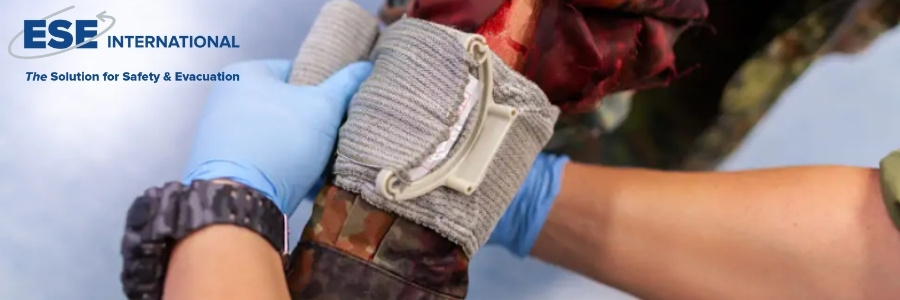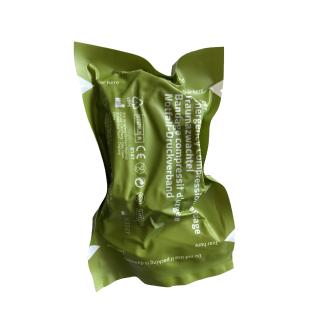Een traumazwachtel is een belangrijk verbandmiddel in de EHBO-koffer voor het snel en effectief verlenen van hulp bij ernstige bloedingen en traumatische verwondingen. Het is ontworpen om zowel compressie (druk) als fixatie (stevigheid) te bieden, waardoor bloedingen snel worden gestopt. In dit artikel leggen we je uit wat een traumazwachtel is, waarvoor het dient en hoe je het deze aanbrengt.
Wat is een traumazwachtel?
Een traumazwachtel is een verbandmiddel dat wordt gebruikt om ernstige bloedingen snel te stoppen. Andere benamingen voor een traumazwachtel zijn “Israëlisch noodverband” of “drukverband met klem.” Dit type zwachtel is ontworpen voor noodsituaties waarin snel handelen noodzakelijk is, zoals bij diepe snijwonden, schotwonden of andere traumatische verwondingen.
Waarvoor dient een traumazwachtel?
Een traumazwachtel wordt voornamelijk gebruikt om ernstige bloedingen te stoppen en een wond af te dekken. Het wordt ingezet bij verwondingen waarbij een normaal verband niet voldoende druk uitoefent om het bloeden te stelpen.
De zwachtel wordt toegepast bij incidenten waar direct levensgevaar is door veel bloedverlies, zoals bij ongevallen, gevechtssituaties, of industriële ongelukken. Het is een cruciaal hulpmiddel voor hulpverleners, omdat het eenvoudig en snel aan te brengen is.
Waaruit bestaat een traumazwachtel?
Een traumazwachtel bestaat uit de volgende onderdelen:
- Een absorberend wondkussen: dit deel van de zwachtel plaats je direct op de wond om bloed te absorberen.
- Elastische zwachtel: de zwachtel zorgt voor compressie (druk) op de wond en zorgt dat het wondkussen op de juiste plaats blijft.
- Drukklem: de drukklem gebruik je om extra druk op de wond uit te oefenen, hierdoor wordt de bloeding gestopt.
- Sluitingsmechanisme: met het sluitingsmechanisme, vaak een haak of clip, zorg je ervoor dat de zwachtel stevig blijft zitten, zelfs bij bewegingen.
In welke sectoren wordt de traumazwachtel gebruikt?
De traumazwachtel wordt gebruikt in diverse sectoren, waaronder:
- Zorgsector en ziekenhuizen: voor snelle wondverzorging bij ernstig letsel.
- Hulpdiensten en brandweer: voor eerste hulp bij ernstige ongevallen.
- Defensie: traumazwachtels worden vaak gebruikt door militairen in het veld, waar snelle behandeling van verwondingen van levensbelang is.
- Industriële sectoren: in sectoren met een hoog risico op ongevallen, zoals de bouw of fabrieken, is een traumazwachtel een essentieel onderdeel van de EHBO-uitrusting.
- Outdoor- en sportsector: bij extreme sporten of in afgelegen gebieden waar hulpdiensten niet direct beschikbaar zijn.
Traumazwachtel aanleggen doe je zo:
Het correct aanleggen van een traumazwachtel is noodzakelijk voor het juist behandelen van verwondingen. Volg hiervoor onderstaande stappen:
Stap 1: Wondkussen op de wond plaatsen
Plaats het absorberende kussen direct op de wond, zorg ervoor dat het hele verwonde gebied bedekt is. Zorg ook dat de klem overeind staat.
Stap 2: Wikkel de elastische zwachtel
Begin met het wikkelen van de elastische zwachtel over het wondkussen heen. Als je met de zwachtel bij de klem komt, haal je deze hier doorheen en ga je de andere kant op. Hierdoor wordt de klem aangetrokken.
Stap 3: Kruislings zwachtelen
Afhankelijk van de plaats van de wond, zwachtel je kruislinks. Zorg ervoor dat je strakke slagen maakt om voldoende druk uit te oefenen. Het is belangrijk dat je hierbij over de drukklem heen zwachtelt.
Stap 4: Maak de zwachtel vast met het sluitingsmechanisme
Blijf de elastische zwachtel wikkelen, zodat het wondkussen en de drukklem volledig bedekt zijn. Gebruik het sluitmechanisme van de zwachtel om het stevig vast te zetten.
Stap 5: Controleer de bloeding
Na het aanleggen, controleer of de bloeding is gestopt. Als de bloeding aanhoudt, overweeg om extra druk uit te oefenen of indien nodig een tweede traumazwachtel aan te brengen.
Medische disclaimer: Dit artikel is uitsluitend bedoeld voor informatieve doeleinden en vervangt geen professionele medische advies. Het aanleggen van een traumazwachtel moet altijd worden uitgevoerd door een getrainde BHV’er of EHBO’er. Bij ernstige verwondingen moet je direct 112 bellen of een arts raadplegen.



